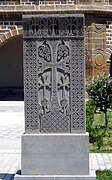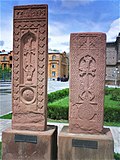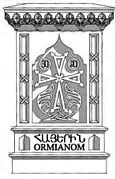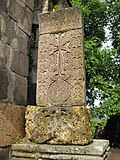Khachkar
Jump to navigation
Jump to search
English: A Khachkar ("Խաչքար" in Armenian, meaning cross-stone) is a carved, memorial stele bearing a cross, and often with additional motifs such as rosettes, interlaces, and botanical motifs. After being blessed and anointed, the Khachkar is believed to possess holy powers and can provide help, protection, victory, long life, remembrance and mediation towards salvation of the soul. Among more than 50,000 Khachkars in Armenia, each has its own pattern, and no two are alike. Khachkar craftsmanship is transmitted through families or from master to apprentice, teaching the traditional methods and patterns, while encouraging regional distinctiveness and individual improvisation.
Since 2010, khachkars are included in UNESCO list of Intangible Cultural Heritage.
-
A khachkar behind the cathedral in Echmiadzin, Armenia. Place of origin is unknown
-
These two khachkars, originally from Jugha were taken to Etchmiadzin, Armenia to be put on display.
-
Khachkar near St. Nicholas Catholic Church in Cracow, Poland. Raised to commemorate the victims of 1915 Armenian Genocide and the glorious history of Armenian community in Poland.
-
Khachkar from the garden on St. Lazzaro degli Armeni - the island near Venice, Italy
-
Khachkar in Brunswick, Germany
-
Khachkar standing by Armenian Catedral in Lviv, Ukraine
-
Khachkar in the wall of Armenian Church of St. Serge (Surb Sarkis), Theodosia, Crimea, Ukraine
-
Khachkar at Haghartsin monastery near Dilijan, Armenia
-
Khachkar by Momik
-
A khachkar at Cathedral of Saint James in the Armenian Quarter of Jerusalem
-
A khachkar from Old Julfa’s cemetery, now in Ēǰmiacin. The khachkars in the cemetery have since been leveled in an act of cultural vandalism by the Azerbaijani government.











